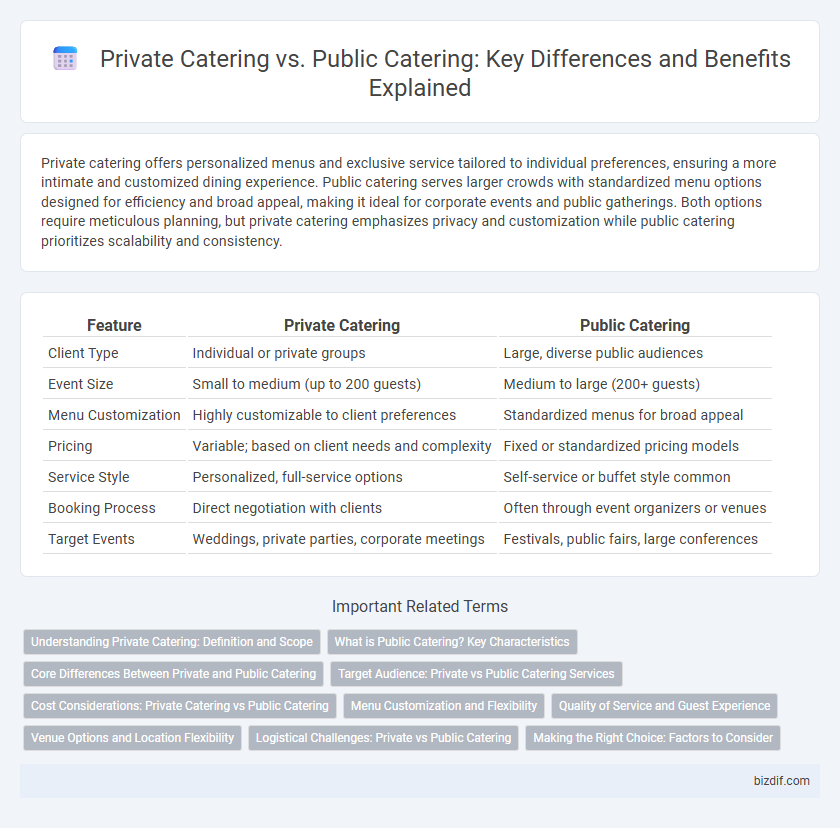Private catering offers personalized menus and exclusive service tailored to individual preferences, ensuring a more intimate and customized dining experience. Public catering serves larger crowds with standardized menu options designed for efficiency and broad appeal, making it ideal for corporate events and public gatherings. Both options require meticulous planning, but private catering emphasizes privacy and customization while public catering prioritizes scalability and consistency.
Table of Comparison
| Feature | Private Catering | Public Catering |
|---|---|---|
| Client Type | Individual or private groups | Large, diverse public audiences |
| Event Size | Small to medium (up to 200 guests) | Medium to large (200+ guests) |
| Menu Customization | Highly customizable to client preferences | Standardized menus for broad appeal |
| Pricing | Variable; based on client needs and complexity | Fixed or standardized pricing models |
| Service Style | Personalized, full-service options | Self-service or buffet style common |
| Booking Process | Direct negotiation with clients | Often through event organizers or venues |
| Target Events | Weddings, private parties, corporate meetings | Festivals, public fairs, large conferences |
Understanding Private Catering: Definition and Scope
Private catering involves providing customized food and beverage services exclusively for personal events such as weddings, corporate functions, or private parties, ensuring tailored menus and personalized service. The scope of private catering encompasses intimate gatherings where dietary preferences, theme consistency, and client-specific requirements are prioritized to enhance the overall experience. Unlike public catering, which serves larger, more generalized audiences, private catering focuses on exclusive attention to detail and personalized hospitality.
What is Public Catering? Key Characteristics
Public catering involves providing food services to a broad and diverse group of customers in public venues such as festivals, stadiums, or corporate events, emphasizing high-volume meal preparation and efficient service delivery. Key characteristics include standardized menus designed for quick service, adherence to strict health and safety regulations, and the ability to accommodate large numbers of guests simultaneously. This type of catering relies heavily on logistical coordination and mass production techniques to maintain quality and consistency under time constraints.
Core Differences Between Private and Public Catering
Private catering serves exclusive events such as weddings and corporate functions, providing personalized menus tailored to individual client preferences and dietary requirements. Public catering operates in open venues like festivals, stadiums, or company cafeterias, focusing on mass production, consistency, and quick service to accommodate a large, diverse audience. Key differences include customer exclusivity, menu customization, service style, and scale of operation.
Target Audience: Private vs Public Catering Services
Private catering services primarily target individual clients, such as families or small groups, focusing on personalized menus and intimate event settings like weddings or corporate meetings. Public catering serves larger, diverse audiences at events like festivals, conferences, or community gatherings, requiring scalable food options and efficient service logistics. The distinct focus on audience size and event type drives differences in menu customization, service style, and operational planning between private and public catering.
Cost Considerations: Private Catering vs Public Catering
Private catering often incurs higher costs due to personalized menu options, exclusive venues, and tailored service staff, making it ideal for intimate events or corporate functions requiring customization. Public catering benefits from economies of scale, utilizing bulk purchasing and standardized menus to reduce per-person expenses, which suits large gatherings or community events. Understanding these cost dynamics helps clients balance budget constraints with desired service levels when choosing between private and public catering options.
Menu Customization and Flexibility
Private catering offers extensive menu customization and flexibility, allowing clients to tailor dishes to specific dietary needs, preferences, and event themes, ensuring a personalized culinary experience. Public catering typically provides standardized menus with limited options, designed for efficiency and broader appeal at large-scale events. This distinction highlights private catering's advantage in creating unique, customized menus compared to the fixed offerings of public catering services.
Quality of Service and Guest Experience
Private catering often delivers a higher quality of service by tailoring menus and presentation to individual preferences, enhancing the overall guest experience. Public catering typically emphasizes efficiency and volume, which can limit customization and reduce personalized attention. Exclusive settings in private catering allow for more meticulous service and intimate guest interactions, elevating satisfaction levels.
Venue Options and Location Flexibility
Private catering offers exclusive venue options like private homes, event halls, and unique locations, allowing tailored ambiance and control over guest experience. Public catering typically occurs in fixed venues such as restaurants, hotels, or public events, limiting location flexibility but benefiting from established facilities. Location flexibility in private catering enhances customization for weddings, corporate events, and social gatherings, accommodating diverse client preferences and specific logistical needs.
Logistical Challenges: Private vs Public Catering
Private catering involves managing smaller, more controlled guest lists, which allows for tailored menu options and precise timing but requires meticulous coordination of personalized services and venue-specific logistics. Public catering demands scalable operations to accommodate large crowds, extensive equipment setup, and efficient crowd flow management, often necessitating collaboration with multiple suppliers and adherence to public safety regulations. Both types face unique logistical challenges that impact staffing, transportation, and inventory control, with private catering prioritizing customization and public catering emphasizing efficiency and capacity.
Making the Right Choice: Factors to Consider
Choosing between private catering and public catering hinges on key factors such as event size, guest preferences, and budget constraints. Private catering offers personalized menus and intimate service tailored to specific dietary needs, while public catering excels in accommodating larger groups with standardized options. Evaluating the scale of the event, desired customization level, and logistical requirements ensures the right catering option aligns seamlessly with client expectations.
Private Catering vs Public Catering Infographic

 bizdif.com
bizdif.com